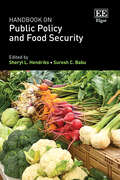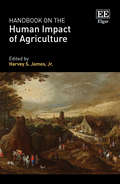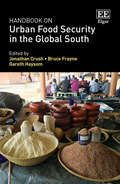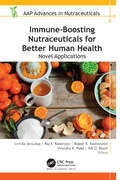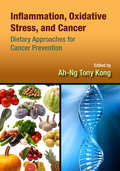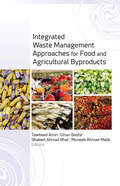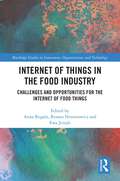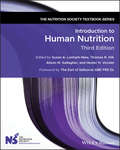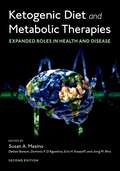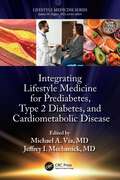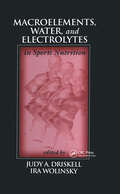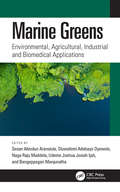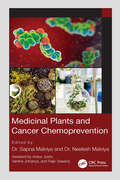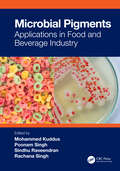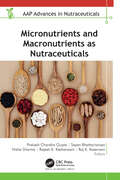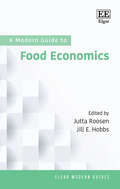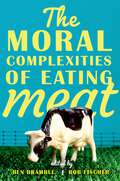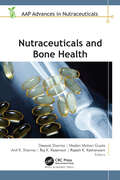- Table View
- List View
Handbook on Public Policy and Food Security
The Handbook on Public Policy and Food Security provides multi-disciplinary insights into food security analysis across the Sustainable Development Goals (SDGs). As food security is an essential outcome and a part of sustainable and healthy food systems, this Handbook addresses the urgent need to provide a comprehensive overview of the field’s current developments.Paired chapters focuses on a specific SDG in turn, presenting an overview and using qualitative and quantitative methodological approaches to assess the impact of food security on the attainment of the specific goal, and the evaluation of the impact of the goal on food security. This Handbook brings together experts in the field who advocate for a food systems approach, highlighting how various components of a food system function together to achieve the goal of food security for all. The cross-policy themes covered extend beyond the SDGs, proving relevant for public policy and food security in the foreseeable future. This erudite Handbook will be highly informative for academics, researchers and students in agricultural economics, development studies, human geography, human rights and comparative social policy. It will also be beneficial for professionals working in public policy, NGOs and multilateral organisations who are interested in understanding food security and nutrition monitoring.
Handbook on the Human Impact of Agriculture
This timely Handbook synthesizes and analyzes key issues and concerns relating to the impact of agriculture on both farmers and non-farmers. With a unique focus on humans rather than animals or the environment, the book is interdisciplinary and international in scope, with contributions from sociologists, economists, anthropologists and geographers providing case studies and examples from all six populated continents.Looking at the pervasive impact of agriculture, the Handbook explores all aspects of the production of food and fiber within the agrifood value chain, including: farmers and laborers growing crops and raising livestock, businesses supplying inputs for these operations, and processors transforming plants and animals into intermediate and finished food, beverage and clothing products. Separated into four parts, it analyzes how the agrifood industry affects farmer well-being; the application of science and technology within an agricultural context; the ways in which agriculture affects the well-being of smallholder farmers, especially in developing countries; and agriculture’s impact more broadly on society.This will be a beneficial read for economics and sociology students, particularly those looking at the impacts of agriculture. Accessible and clear, the Handbook will also be helpful for policymakers and agricultural NGOs wanting a more in-depth understanding of the impact of agriculture on human life.
Handbook on Urban Food Security in the Global South
The ways in which rapid urbanization of the Global South are transforming food systems and food supply chains, and the food security of urban populations is an often neglected topic. This international group of authors addresses this profound transformation from a variety of different perspectives and disciplinary lenses, providing an important corrective to the dominant view that food insecurity is a rural problem requiring increases in agricultural production. Starting from the premise that food security in urban areas is primarily a challenge of food access, the chapters explore the various economic, social, and governance policies and structures that constrain and inhibit the access of all to food of sufficient quantity and quality. As the Global South continues to urbanize, the challenge of feeding hungry cities will become even more daunting, and this Handbook explains why the existing food system, although undergoing rapid change, is inadequate for this task and cannot meet the challenge without substantial reform. The Handbook as a whole, and the individual chapters, provide comprehensive overviews of relevant themes mixed with empirical, real-world examples for university readership teaching and taking courses on food systems, migration and urbanization, urban policy and planning, geography, agricultural economics, public health, and international development. It will also introduce practitioners to current debates in the field and provide strong support for the renewed, and growing, focus on the food security of urban populations. The Handbook’s comprehensive overviews of relevant themes mixed with empirical, real-world examples are ideal for university readership. It will also introduce practitioners to current debates in the field and provide strong support for the renewed, and growing, focus on the food security of urban populations.
Immune-Boosting Nutraceuticals for Better Human Health: Novel Applications (AAP Advances in Nutraceuticals)
This new volume discusses the valuable contribution of immune-boosting properties of nutraceuticals and functional foods toward human health, exploring dietary antioxidants, vitamins and minerals, edible microalgae, herbs, phytonutrients, omega 3-fatty acids, and probiotics. The volume addresses the immune-boosting properties of herbs and vegetables and the pharmacological and therapeutic importance of commonly used medicinal herbs and carotenoids-containing vegetables and their immunological and biological actions for treating disease and maintaining health. Several chapters focus on marine-derived sources used to boost immunity, such as microalgae-derived compounds and compounds from coral reefs, which can promote better health and alleviate the risk of development of degenerative diseases.
Inflammation, Oxidative Stress, and Cancer: Dietary Approaches for Cancer Prevention
Increasing scientific evidence suggests that the majority of diseases including cancer are driven by oxidative stress and inflammation, attributed to environmental factors. These factors either drive genetic mutations or epigenetically modify expression of key regulatory genes. These changes can occur as early as gestational fetal development, and
Integrated Waste Management Approaches for Food and Agricultural Byproducts
Food wastage has become a major problem with about one third of all food produced for human consumption going to waste, leading to major socioeconomic and environmental consequences in an increasingly resource-constrained world. This volume embraces integrated management as a solution to food and agricultural wastage. It presents methods to lessen, reuse, recycle, and manage wastage by merging and employing a variety of suitable methods, equipment, and organizational plans. The volume begins with a global overview of the characterization of food and agricultural wastes. It then delves into using food processing applications that use byproducts as sources of valuable bioenergy and recoverable products. It explores methods for reducing, reusing, and recycling waste along with basic and modern environmental practices for food and agricultural waste management. Chapters discuss food waste management in conjunction with enhancing food security and sustainability and management strategies that offset the impact of food and agricultural wastes on the environment. Finally, the book looks at the challenges and opportunities that are associated with food and agricultural waste management across the globe.
Internet of Things in the Food Industry: Challenges and Opportunities for the Internet of Food Things (Routledge Studies in Innovation, Organizations and Technology)
The food industry is experiencing a digital transformation across the entire supply chain, from farm to fork. This book offers comprehensive insights into the challenges and opportunities faced, specifically examining the application of the Internet of Things. The authors analyse the benefits and the related threats from the perspective of the participants of the entire supply chain, including consumers. Taking the reader on a journey, this book begins with an analysis of technology use in farming, production, logistics and retailing before delving into the use of digitalization in educating consumers on sustainable consumption practices. The multifaceted analysis of the Internet of Food potential combines science and practice, enriching theoretical analysis with case studies. This book will be of interest to those researching and studying supply chain management, logistics, innovation and technology management and consumption, with a particular interest in the food industry.
Introduction to Human Nutrition (The Nutrition Society Textbook)
Now in its third edition, the best-selling Introduction to Human Nutrition continues to foster an integrated, broad knowledge of the discipline and presents the fundamental principles of nutrition science in an accessible way. With up-to-date coverage of a range of topics from food composition and dietary reference standards to phytochemicals and contemporary challenges of global food safety, this comprehensive text encourages students to think critically about the many factors and influences of human nutrition and health outcomes. Offers a global, multidisciplinary perspective on food and nutrition Covers nutrition and metabolism of proteins, lipids, carbohydrates and vitamins and minerals Explores new developments in functional foods, supplements and food fortification, and future challenges for nutrition research and practice Explains the digestion, absorption, circulatory transport, and cellular uptake of nutrients Demonstrates the structure and characteristics of nutrients, and the relationship with disease prevention A primary text in nutritional science classes worldwide, Introduction to Human Nutrition is a vital resource for students in areas of nutrition, dietetics, and related subjects that involve principles of nutrition science.
Jews and Their Foodways (Studies in Contemporary Jewry)
Food is not just a physical necessity but also a composite commodity. It is part of a communication system, a nonverbal medium for expression, and a marker of special events. Bringing together contributions from fourteen historians, anthropologists, sociologists, and literary critics, Volume XXVIII of Studies in Contemporary Jewry presents various viewpoints on the subtle and intricate relations between Jews and their foodways. The ancient Jewish community ritualized and codified the sphere of food; by regulating specific and detailed culinary laws, Judaism extended and accentuated food's cultural meanings. Modern Jewry is no longer defined exclusively in religious terms, yet a decrease in the role of religion, including kashrut observance, does not necessarily entail any diminishment of the role of food. On the contrary, as shown by the essays in this volume, choices of food take on special importance when Jewish individuals and communities face the challenges of modernity. Following an introduction by Sidney Mintz and concluding with an overview by Richard Wilk, the symposium essays lead the reader from the 20th century to the 21st, across Europe, the Middle East, Africa, and North America. Through periods of war and peace, voluntary immigrations and forced deportations, want and abundance, contemporary Jews use food both for demarcating new borders in rapidly changing circumstances and for remembering a diverse heritage. Despite a tendency in traditional Jewish studies to focus on "high" culture and to marginalize "low" culture, Jews and Their Foodways demonstrates how an examination of people's eating habits helps to explain human life and its diversity through no less than the study of great events, the deeds of famous people, and the writings of distinguished rabbis.
Ketogenic Diet and Metabolic Therapies: Expanded Roles in Health and Disease
Ketogenic diets have treated epilepsy for nearly 100 years, yet metabolic therapy has remained obscure and underutilized for most of this time. In recent decades, the clinical efficacy of ketogenic therapy was confirmed definitively for pediatric epilepsy and has now expanded to adult epilepsy. Now, the benefits of metabolic therapy have been extended well beyond epilepsy to additional neurological, metabolic, and genetic disorders, and the importance of metabolic health is recognized as paramount. This new edition of Ketogenic Diet and Metabolic Therapies: Expanded Roles in Health and Disease highlights the growing research and clinical applications of metabolic therapies as effective in disease treatment, reversal and prevention. Emerging mechanisms include the landscape of the microbiome and epigenetics. Consistent with the first observations in 1921, in some cases metabolism-based strategies have proven equal or superior to pharmacological treatments for specific diseases and for treating multiple comorbidities. This second edition commemorates the 100th anniversary of the ketogenic diet, shares new research in this rapidly moving field, and offers a valuable collection of high-resolution color figures. The team of editors for this edition have been working in this area for decades, and in this volume, they have assembled world leaders in this cutting-edge research. As the first academic, interdisciplinary book on ketogenic diet and metabolic therapy, this volume will be crucial during this time of increased appreciation for metabolic health in professionals and the public alike.
Kitchen knives (Large Print)
This is an image of three kitchen knives. The blades are pointing towards the top of the page and the handles are at the bottom. There is a locator dot shown, which will be at the top left of the page when the image is the correct way up. There are two rivets on each knife handle to secure them to the blade. The sharp edges are to the right of each knife.Test your tactile skills: - Can you find the bread knife with the serrated edge blade?- Find the small paring knife.- Which is the longest knife, the bread knife or the chef's knife on the right of the page?
Kitchen knives (UEB Contracted)
This is an image of three kitchen knives. The blades are pointing towards the top of the page and the handles are at the bottom. There is a locator dot shown, which will be at the top left of the page when the image is the correct way up. There are two rivets on each knife handle to secure them to the blade. The sharp edges are to the right of each knife.Test your tactile skills: - Can you find the bread knife with the serrated edge blade?- Find the small paring knife.- Which is the longest knife, the bread knife or the chef's knife on the right of the page?
Kitchen knives (UEB Uncontracted)
This is an image of three kitchen knives. The blades are pointing towards the top of the page and the handles are at the bottom. There is a locator dot shown, which will be at the top left of the page when the image is the correct way up. There are two rivets on each knife handle to secure them to the blade. The sharp edges are to the right of each knife.Test your tactile skills: - Can you find the bread knife with the serrated edge blade?- Find the small paring knife.- Which is the longest knife, the bread knife or the chef's knife on the right of the page?
Leek (Large Print)
This is an image of a leek standing vertically in the middle of the page. There is a locator dot shown, which will be at the top left of the page when the image is the correct way up. The leek is a member of the Allium family, which includes garlic, onions, shallots and scallions. At the top centre of the page are the leaf tips. There are lines on the image that represent the fine channels running the length of the leaves. The leaves overlap each other and at the bottom of the page, they form a solid bulb, from which the plants roots grow. The plants colour changes from dark green at the top to white at the bottom of the page where the leaves are covered with soil during growth.
Leek (UEB Contracted)
This is an image of a leek standing vertically in the middle of the page. There is a locator dot shown, which will be at the top left of the page when the image is the correct way up. The leek is a member of the Allium family, which includes garlic, onions, shallots and scallions. At the top centre of the page are the leaf tips. There are lines on the image that represent the fine channels running the length of the leaves. The leaves overlap each other and at the bottom of the page, they form a solid bulb, from which the plants roots grow. The plants colour changes from dark green at the top to white at the bottom of the page where the leaves are covered with soil during growth.
Leek (UEB Uncontracted)
This is an image of a leek standing vertically in the middle of the page. There is a locator dot shown, which will be at the top left of the page when the image is the correct way up. The leek is a member of the Allium family, which includes garlic, onions, shallots and scallions. At the top centre of the page are the leaf tips. There are lines on the image that represent the fine channels running the length of the leaves. The leaves overlap each other and at the bottom of the page, they form a solid bulb, from which the plants roots grow. The plants colour changes from dark green at the top to white at the bottom of the page where the leaves are covered with soil during growth.
Lifestyle Medicine for Prediabetes, Type 2 Diabetes, and Cardiometabolic Disease (Lifestyle Medicine)
Lifestyle change is universally recommended for patients with type 2 diabetes and cardiometabolic disease, yet, the majority of clinical practice, educational programs, and clinical trials within these chronic disease spaces focus on medication use and procedures, with insufficient emphasis on lifestyle medicine. The concept of lifestyle medicine can serve as a countermeasure, acting through aspects of personal choice, natural and built environments, cultural traditions, and socioeconomic influences that affect the metabolic health of an individual. Integrating Lifestyle Medicine for Prediabetes, Type 2 Diabetes, and Cardiometabolic Disease provides clinical evidence for and a mechanistic understanding of the six pillars of lifestyle medicine. It guides the reader to identify opportunities for early intervention rather than focus on the diagnosis and treatment of the established disease. Interventions at earlier points have the potential to mitigate progression, prevent complications, reduce costs, and improve a patient’s overall health at all points in their lifetime. Key Features Provides mechanistic, epidemiological, and clinical understanding of all pillars of lifestyle medicine Presents information on mechanisms for lifestyle medicine in cardiometabolic disease Features a unique model that includes recognition of predisease and even pre-predisease with rationale for intervention Promotes evidence-based recommendations for all stages of cardiometabolic disease This volume in the Lifestyle Medicine series is an essential resource for clinicians and students, providing them with information to help them to prevent complications, reduce costs, and improve a patient’s overall health at all points in their lifetime.
Macroelements, Water, and Electrolytes in Sports Nutrition
The media extols the health benefits of good nutrition and physical activity. Since exercise and sport is becoming a bigger concern to the general public and not just elite athletes, the interest in research in this field is growing. Macroelements, Water and Electrolytes in Sport Nutrition addresses the relationship of macroelement needs and interactions to sports and exercise. Research indicates that work capacity and other measures of physical performance are influenced by the intake of water as well as several of the macroelements, including electrolytes. This book examines the convincing, and the not so convincing, evidence about the connection between exercise and sports activities and the nutrient status of individuals.Written by individuals from various academic disciplines, the book is a comprehensive, indispensable resource for scientists and practitioners with an interest in sports nutrition. It provides a review of topics related to water, macroelements, and exercise as well as identifies gaps in our knowledge, encouraging researchers to build upon the existing knowledge and advance our understanding of sport nutrition.
Marine Greens: Environmental, Agricultural, Industrial and Biomedical Applications
This book provides an in-depth overview of marine greens and their environmental and biotechnological applications. It addresses concepts such as the niche adaptation strategies of marine greens in their natural habitats, as well as their global distribution, and factors affecting their distribution and proliferation.Marine greens are posited as an alternative to fossil fuels, mitigating global climate change and thereby fostering future environmental sustainability. In addition, the book explains the remediation of xenobiotics, wastewater, microplastics, marine debris and marine green contamination. Expert authors from around the world explore the industrial and agricultural applications of marine greens in the production of enzymes and marine bioenergy, and what is needed to improve its production potential.This is important reading for government and non-governmental organizations as well as industries and research institutions looking for ways to combat current industrial and environmental challenges.
Medicinal Plants and Cancer Chemoprevention
Cancer is the second leading cause of death globally. Medicinal Plants and Cancer Chemoprevention provides information on the use of various herbal plants used as anticancer agents. It discusses the traditional system of medicine and focuses on plant-derived compounds for cancer therapy with integrated approaches. Chapters present information on various medicinal plants that covers background and history, ethnomedical considerations, morphology, phytochemistry, and pharmacological properties. The book presents a scientific investigation on medicinal plants in managing cancer, reported mechanisms of action as anticancer activity, as well as covering the toxicological aspects of certain plants. KEY FEATURES: · Details information on plant-derived compounds for cancer therapy. · Features information on methods of extraction and isolation of various phytoconstituents responsible for anticancer activity. · Discusses herbal formulations and alternative approaches used for the management and treatment of cancer. · Demonstrates the importance of alternative approaches including yoga, acupuncture, and dietary supplements to be effective in the management of cancer. This book is helpful to botanists, researchers and practitioners in alternative and complementary medicine, and the herbal medicine research community.
Microbial Pigments: Applications in Food and Beverage Industry
Microbial Pigments: Applications in Food and Beverage Industry offers a comprehensive and updated review of the impact of microbial pigments as value-added products in the food and beverage industry. Microbes produce a range of valuable pigments such as carotenoids, flavins, melanins, quinines, and violacein. The book explores the use of microbial pigments as additives, antioxidants, color intensifiers, and functional food ingredients. It discusses pigment isolation and processing technologies. It covers a range of applications across products like jams, spreads, frozen desserts, and beverages. The book also discusses food safety and toxicology aspects. Key features Explores the various microbial pigments and their sources Reviews the pigment isolation, production, and processing techniques Discusses the potential application of pigments across a range of products in the food and beverage industry Includes the latest innovations and patents awarded in use of microbial pigments as value-added food products The book is meant for researchers, academic and industry experts in food biotechnology, food processing, and food microbiology.
Micronutrients and Macronutrients as Nutraceuticals (AAP Advances in Nutraceuticals)
This new volume explains in detail the properties of micronutrients and macronutrients and their diverse uses as nutraceuticals for their beneficial properties, such as their antioxidant activity and immunity-boosting properties and how they can be incorporated into the human diet for optimum health, for growing beneficial bacteria in the gut, and inhibition of pathogens. Interestingly, the authors look at how disease-promoting habits often unfold in childhood, even prenatally, and employing nutrigenomics early on goes a long way toward curbing these chronic diseases later on in life. With the advent of increasing drug costs and escalating antimicrobial resistance, the pharmacological and antibiotic-like effects of naturally derived nutraceuticals are worth exploring. This volume provides important information toward that goal that will be valuable for researchers, faculty, and graduate students in medical microbiology, pharmacy, chemical engineering, and medical informatics.
A Modern Guide to Food Economics (Elgar Modern Guides)
This Modern Guide provides detailed theoretical and empirical insights into key areas of research in food economics. It takes a forward-looking perspective on how different actors in the food system shape the sustainability of food production, distribution, and consumption, as well as on major challenges to efficient and inclusive food systems.Analysing the main characteristics of modern food markets, chapters introduce readers to the economics of food systems, product differentiation, the mediating role of food retailers, and the increasing significance and complexity of international trade in food. Encapsulating new methods in the study of food economics and policy, this Modern Guide explores changes in food value chains and consumption. It further pushes the boundaries of food economics to include economic perspectives on the role of social media and technology such as genomics in shaping food systems.Offering key insights into the state-of-the-art debates in the field, this Modern Guide will be critical reading for graduate students and researchers of food economics. It will also be a timely book for practitioners in the field wishing to take a fresh look at issues shaping food systems.
The Moral Complexities of Eating Meat
A new collection offering provocative and often counterintuitive conclusions on the ethics of meat eating In a world of industralized farming and feed lots, is eating meat ever a morally responsible choice? Is eating organic or free range sufficient to change the moral equation? Is there a moral cost in not eating meat? As billions of animals continue to be raised and killed by human beings for human consumption, affecting the significance and urgency in answering these questions grow. This volume collects twelve new essays by leading moral philosophers who address the difficult questions surrounding meat eating by examining various implications and consequences of our food choices. Some argue for the moral permissibility of eating meat by suggesting views such as farm animals would not exist and flourish otherwise, and the painless death that awaits is no loss to them. Others consider more specific examples like whether buying french fries at McDonalds is just as problematic as ordering a Big Mac due to the action's indirect support of a major purveyor of meat. The Moral Complexities of Eating Meat is a stimulating contribution to the ongoing debate on meat consumption and actively challenges readers to reevlaute their stand on food and animal ethics.
Nutraceuticals and Bone Health (AAP Advances in Nutraceuticals)
Here is an informative volume on the importance of nutraceuticals and herbal remedies for bone health. It explains the probable mechanisms of nutraceuticals for the prevention, treatment, and management of bone-related diseases as well as their curable effects on bone injuries. The volume covers the progression and development of bones, which is a multifaceted process that requires an endless and ample supply of nutrients, such as calcium, phosphorus, potassium, protein, vitamin D, magnesium, and fluoride. The book delves into the beneficial effects of nutraceuticals on overall bone health and for the treatment of bone disorders such as osteoporosis, bone fractures, scoliosis and related complications, rheumatoid arthritis, Paget’s disease, bursitis, gout, and carpal tunnel syndrome. It also addresses the use of nutraceuticals for inflammatory deformities and rickets.
